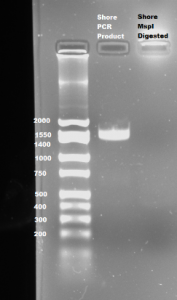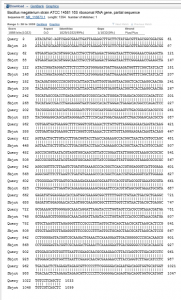Bacillus megaterium is a cytokinin promoting bacterium used to promote plant root overgrowth. The possible applications of Bacillus megaterium is being examined in the deserts of Egypt for the promotion of desert agriculture by Köberl and others. It is a gram-positive, rod shaped, spore forming bacteria. It is used in the biocontrol of plant diseases and nitrogen fixation has been demonstrated in some strains (2011).
References:
Köberl, Martina ; Müller, Henry ; Ramadan, Elshahat M. ; Berg, Gabriele. 2011. Desert Farming Benefits from Microbial Potential in Arid Soils and Promotes Diversity and Plant Health. PLOS. 6 (9):): e24452.
Date of Collection from Buffalo Creek Shore: February 8
Methods for isolation and identification:
- 1.1 g of soil from the shore of Buffalo Creek (Figure 1) was combined with 12 mL of sterilized water. 20 uL of the fluid was then added to 180 uL sterilized water to produce the Shore 1:10 dilution sample. This dilution was spread onto a nutrient agar plate using a sterile plastic hook. The plate was left to grow at room temperature for 48 hours.
- A bright yellow colony was chosen for DNA sequencing and isolation (Figure 2). The 16s rRNA of the colony was amplified using PCR whose product was then digested via MspI.
- Identity of bacteria was determined using DNA sequence.

Figure 1: Shore Collection Site

Figure 2: Colony Isolated for Identification
Results:
- Gel Electrophoresis for MspI Digestion (Figure 3): Purity of product was indicated by prominence of base-pair marker. Both bars were prominent indicating purity of product was high. MspI digestion product was lodged at the start of the lane and unable to be run. 1550 base pairs was determined to be the amount of base pairs in the undigested PCR products.

Figure 3: Gel Electrophoresis Plate for Shore Bacteria.
- Identification of Bacteria using BLAST (Figure 4): The sequence of Bacillus megaterium was compared at the gaps to our DNA sequence. This file contains the DNA sequence of the isolated bacteria: SETAS_PREMIX_JF7529_1. The closest match to our bacterium was Bacillus megaterium.

Figure 4: BLAST Query For Bacteria Identified as Bacillus megaterium.
Contributed to by: Sandra Elsakr and Taylor Alvey Biology 250, Spring 2017.